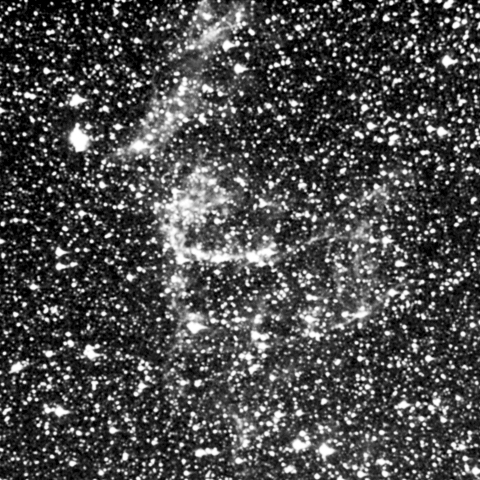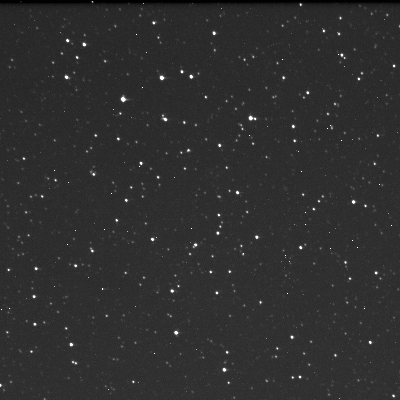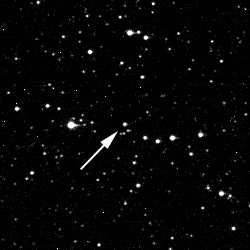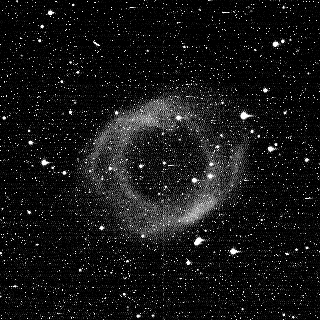Choose Target → Adjust Settings → Provide Information → Submit
Back to Thumbnail View
Stars & Nebulae
Hercules Cluster
- Object Type: Star Cluster
- Distance: 25,000 light years
- Constellation: Hercules
Hercules cluster, also called M13, is dense ball of hundreds of thousands of stars. M13 is one of over a hundred "globular clusters" that orbit the center of our Milky Way Galaxy. Globular clusters are ancient, and their 12 billion year-old stars are among the oldest in the Universe. In your OWN image of M13, estimate the number of stars you can see.
Explore more with NASA's Hubble Space Telescope

Orion Nebula
- Object Type: Star forming region
- Distance: 1500 light years
- Constellation: Orion
The Orion nebula is an immense stellar nursery where clouds of dust and gas collapse under gravity to make the next generation of stars. It is also the closest star-forming region to us, and can be seen with the unaided eye in the constellation of Orion. In your OWN image of the Orion Nebula, look for the bright stars at the center of the nebula. It is the light from these newborn stars that make the nebula glow.
Explore more with NASA's Spitzer Space Telescope

Pleiades
- Object Type: Star cluster
- Distance: 440 light years
- Constellation: Taurus
The Pleiades is a cluster of several thousand stars, but only the biggest and brightest 6 to 8 are visible to the unaided eye. All the stars were born out of the same cloud of gas and dust about 100 million years ago and will eventually drift apart. Galileo observed the cluster in 1610 and counted 40 stars. How many stars do you count in your OWN image?
Explore more with NASA's Hubble Space Telescope

Ring Nebula
- Object Type: Planetary nebula
- Distance: 2300 light years
- Constellation: Lyra
Called a planetary nebula because it looks like a planet through small telescopes, the Ring Nebula is actually the outer atmosphere of a dying star. When a star like the Sun runs out of nuclear fuel, the outer atmosphere is blown off into space, creating a planetary nebula and leaving behind an Earth-sized core we call a white dwarf star. How does your OWN image of the Ring Nebula compare to an image of a planet, say Venus?
Explore more with NASA's Hubble Space Telescope

Milky Way
- Object Type: Stars/nebulae/galaxy
- Distance: Varies
- Constellation: Sagittarius
Almost all the stars and nebulae you can see with the MicroObservatory telescopes are part of our own Milky Way galaxy. Our galaxy is a large disk-shaped spiral of around 300 billion stars, but here on Earth we view the disk from the inside, and so see a milky band of light across the sky. Galileo first resolved this cloudy band into "countless stars" when he turned his telescope skyward in 1612. If you take your OWN wide-field view of the Milky Way, look for huge clouds of gas and dust (nebulae) in addition to countless stars.
Find out more about the Milky Way with NASA's Spitzer Space Telescope

Sagittarius A
- Object Type: Black hole/star cluster/galaxy
- Distance: 26,000 light years
- Constellation: Sagittarius
Look towards the constellation Sagittarius and you look towards the center of our galaxy. Beyond the impenetrable curtain of stars and dust lies Sagittarius A, a turbulent and dangerous place filled with X-ray hot gas and the remnants of exploded stars. Look closer, and you find Sagittarius A*, the giant black hole that resides at the very center of the Milky Way! The stars you see in your OWN image are just the brightest and closest of billions of stars lying between us and the very heart of our galaxy.
Explore more with NASA's Chandra X-ray Observatory

Dumbbell Nebula
- Object Type: Planetary nebula
- Distance: 1300 light years
- Constellation: Vulpecula
An expanding shell of gas from a dying star that was similar to the Sun, the Dumbbell Nebula may offer a glimpse into the future of our own star. Although the Sun has five billion years of nuclear fuel left, the star that created the Dumbbell exhausted its fuel over 50,000 years ago. In its death throes, the star blew off its outer layers to form the beautiful ghostly nebula we see today. The nebula got its popular name because of a double lobe appearance. What shape do you see in your OWN image?
Explore more with NASA's Hubble Space Telescope

Trifid Nebula
- Object Type: Star forming region
- Distance: 5400 light years
- Constellation: Sagittarius
The Trifid Nebula is a stellar nursery, where young hot stars are illuminating the cocoon of gas surrounding them. The light reaching us comes directly from the hot gas, but also from starlight reflected from the dust of the cocoon. It was called the Trifid because in early observations it appeared to be broken into three bright regions by the dust lanes that cross the nebula. How many dust lanes can you see in your OWN image?
Explore more with NASA's Spitzer Space Telescope

Lagoon Nebula
- Object Type: Star forming region
- Distance: 4100 light years
- Constellation: Sagittarius
Resembling a pool of light in the sky, the Lagoon Nebula is a giant cloud of hot hydrogen gas glowing from the intense light of newborn stars. The Lagoon Nebula, like other star-forming regions, can give us an insight into the environment that gave birth to our own Sun 5 billion years ago. What color does the Lagoon look in your OWN color image?
Explore more with NASA's Hubble Space Telescope

Eagle Nebula
- Object Type: Star forming region
- Distance: 7000 light years
- Constellation: Serpens
The Eagle Nebula is an immense star-forming region, where the intense radiation and winds from newborn stars are sweeping away the dust and gas that was left over from their formation. Because of these forces, the majestic dusty pillars that give the Eagle its name will evaporate over the next few million years. Compare the dark dust pillars in your OWN image with the famous Hubble "Pillars of Creation" image. Can you match the two?
Explore more with NASA's Hubble Space Telescope

Crab Nebula
- Object Type: supernova remnant
- Distance: 6500 light years
- Constellation: Taurus
The Crab Nebula is the twisted remains of a giant star that was seen to explode in the year 1054. As the outer parts of the stars exploded, the massive core of the star squeezed down to form a city-sized ball of neutrons called a pulsar. Spinning on its axis 30 times a second, the intense magnetic fields of the Crab pulsar power the expansion of the nebula. Can you see the crab-like pincers in your OWN image that gave the Crab Nebula its name?
Explore more with NASA's Chandra X-Ray telescope

Cygnus X-1
- Object Type: black hole
- Distance: 6000 light years
- Constellation: Cygnus
The first confirmed discovery of a black hole, Cygnus X-1 is a binary system of a normal star and a massive but invisible companion. The black hole reveals its presence in two ways: its gravitational tug on the visible star, and a glow of X-rays as gas from the star is pulled into the black hole. Your OWN image will only reveal the visible companion star of the black hole. Can you tell which star it is?
Explore more with NASA's Chandra X-Ray telescope

Messier 46
- Object Type: Star cluster
- Distance: 5400 light years
- Constellation: Puppis
The brightest stars in the open cluster M46 are 100 times more luminous than our Sun. In your OWN image of M46, can you spot the small disc of a planetary nebula near the cluster? M46 is a cluster of more than 500 young stars. So what is a planetary nebula, which is the remnant of an old dead star, doing there?
Find out more about M46 at NASA's Astronomy Picture of the Day

Messier 15
- Object Type: Globular cluster
- Distance: 34000 light years
- Constellation: Pegasus
A ball of a million stars tightly bound by their mutual gravity, M15 is one of 158 globular clusters that orbit the center of our Milky Way galaxy. Globular clusters contain some of the oldest stars known in the universe, meaning that M15 has been around for most of the history of the universe! In your OWN image of M15, how many individual stars can you count?
Explore more with NASA's Hubble Space Telescope

Beehive Cluster
- Object Type: Star cluster
- Distance: 577 light years
- Constellation: Cancer
One of the largest and nearest "open clusters" in the Milky Way, the Beehive is a swarm of young stars that were born about 600 million years ago. Also called Praesepe, which is Latin for manger, the Beehive had been seen in the sky and recorded since ancient times, but before Galileo's observations, was always described as a little cloud or mist. Through Galileo's telescope the true nature of Praesepe was revealed. Galileo counted 36 stars in the Beehive cluster. How many can your count in your OWN image?
Find out more at NASA's Astronomy Picture of the Day

CQ Cepheus
- Object Type: High mass star
- Distance: 3000 light years
- Constellation: Cepheus
CQ Ceph is a binary star system, where one member of the pair is a rare supermassive star called a Wolf-Rayet star. Wolf-Rayet stars are at the very end of their short luminous lifespan, and this star in CQ Ceph is destined to die at any moment in an immense supernova explosion. While the outer layers of the star will be blown into space, the dense massive core will collapse in on itself forming a black hole. The resulting black hole X-ray binary system will be very similar to Cygnus X-1.
Find out more about CQ Cepheus and Wolf-Rayet stars at the Universe Guide

Algol
- Object Type: Variable star
- Distance: 93 light-years
- Constellation: Perseus
Algol, also known as the "Demon Star", is actually a three-star system. In 1881 Edward Pickering (namesake of MicroObservatory's telescope Ed!) showed that this system includes an eclipsing binary, meaning that one star passes in front of the other from our perspective on Earth. These two stars are about 20 times closer to each other than the Sun and Earth, and they eclipse each other every 2.86 days, for about 10 hours. Algol is about 93 light years away, but 7 million years ago it came within 10 light years of our solar system, and would have been much brighter than any star in our sky today.
Explore more with NASA's What's Up

Delta Cephei
- Object Type: Variable star (a 'Cepheid')
- Distance: 887 light years
- Constellation: Cepheus
Delta Cephei was the first star to be identified as a Cepheid variable star in 1784. In fact, the term 'Cepheid' for variable stars comes from Delta Cephei. Variable Stars pulsate and change in diameter and temperature, resulting in periodic changes in brightness that we can observe from Earth. Henrietta Leavitt, one of Harvard's Computers, discovered how to use the pulsing luminosity of Cepheid stars to measure cosmic distances. The pulsation period for Delta Cephei is about 5 days. Do you observe any change in luminosity in your OWN images?
Explore more with NASA's Spitzer Space Telescope

Beta Lyrae
- Object Type: multiple star system
- Distance: 960 ± 50 light years
- Constellation: Lyra
Beta Lyrae is a multiple star system in the constellation Lyra. It includes two stars that form an eclipsing binary, also known as Sheliak from its Arabic name. Eclipsing binaries occur when two stars orbit one another, and periodically pass in front of one another from our perspective on Earth. One of the two stars grew into a giant star first and used to be larger than its companion. But over time, this star grew so large that it began transferring mass to its companion, and now the companion has grown to be the larger star of the two.
Explore more about Beta Lyrae at Phys.org

Mira
- Object Type: Binary star system
- Distance: 300 ± 30 light years
- Constellation: Cetus
Mira is a binary star system that holds one variable red giant (Mira A) and one white dwarf (Mira B) that orbit around each other. Mira A is only 20 percent more massive than our Sun, but its radius is nearly 400 times larger than the Sun. Mira A is actually pulsing and changing shape, which contributes to its variable brightness. If you watch carefully, you'll notice that the star reaches its brightest point about once every year, and then slowly dims over the next 200 days. One more interesting feature: Mira is leaving a trail of material nearly 13 light years long as it moves through space. A real shooting star!
Explore more with NASA's Spitzer Space Telescope

Omega Centauri
- Object Type: Globular Cluster
- Distance: 15800 light years
- Constellation: Centaurus
After Edmond Halley first identified that this object wasn't a star in 1677, we now know that Omega Centauri is the largest globular star cluster in the Milky Way. Believed to be the leftover core from a separate dwarf galaxy, it contains about 10 million stars, and has a total mass of 4 million times that of our Sun. Omega Centauri is visible with the naked eye, and is about as big as the full moon in the sky. Try blending images of the two objects together in JS9 and see for yourself how they compare.
Explore more with NASA's Hubble Space Telescope

47 Tucanae
- Object Type: Globular cluster
- Distance: 13000 light years
- Constellation: Tucana
47 Tucanae is a globular cluster, meaning that it is a collection of a large number of stars that clump in a sphere around a galactic core. 47 Tucanae is rather massive for a globular cluster, with potentially millions of stars. 47 Tucanae is the second largest globular cluster in the sky, and can be seen with the naked eye about 18 degrees from the south celestial pole. When you can see it clearly, it is about as large as the full moon. This cluster has been useful to scientists for observing white dwarf stars (which our sun will become) moving to the outer regions of the cluster. See any stars in the cluster that remind you of home?
Explore more with NASA's Chandra X-Ray Observatory

Tarantula Nebula
- Object Type: Star forming region
- Distance: 160000 light years
- Constellation: Dorado
The Tarantula Nebula can be seen in the southern sky near the Large Magellanic Cloud. It is about 160,000 light years. However, it is so large, so active and so bright, that if it were as close to us as the Orion Nebula, it would fill the space of 60 full moons in the sky and cast shadows on Earth. At the edge of the Nebula lies one of the closest supernovae ever recorded, which exploded a mere 168,000 light years from Earth. It's too small to see in your OWN images, but it is growing and evolving with every image you capture!
Explore more with NASA's flying telescope SOFIA

Eta Carina
- Object Type: Star forming region
- Distance: 8500 light years
- Constellation: Carina
Eta Carina is one of the largest and most interesting star systems close to our Solar System. Nearly 200 years ago, during its "Great Eruption", Eta Carina grew to be one of the brightest objects in the sky. Although it later dimmed back below naked-eye visibility, it has been growing in brightness again since the mid-1900s. Lying deep within the Homunculus Nebula, two stars of Eta Carina are orbiting one another. There's a possibility that one of the stars of Eta Carina could explode as a supernova in the not-too-distant astronomical future, so keep an eye on your OWN images for any sudden changes!
Explore more at NASA's Goddard Space Flight Center

NGC 2477
- Object Type: Open cluster
- Distance: 3,600 light years
- Constellation: Puppis
NGC 2477 is an open cluster with somewhere around 300 stars. It is rather large for an open cluster and looks almost like a globular cluster, except that it does not have the dense spherical center that gobular clusters all have from their strong gravitational clumping. Another difference is that you will find globular clusters in the outer reaches of a galaxy, but open clusters will grow in the main disk of the galaxy. How would you have characterized NGC2477 if you had discovered it first?
Explore more with the European Southern Observatory

Eight Burst Nebula
- Object Type: Planetary nebula
- Distance: 2,000 light years
- Constellation: Vela
The Eight-Burst Nebula is a planetary nebula that lies approximately 2,000 light years away from Earth. While there are actually two stars at the center of the Eight-Burst Nebula, only one of them is the central white dwarf that shed its outer layers of material to create the planetary nebula you see in your images. The Eight-Burst Nebula is also commonly known as the Southern Ring Nebula. With this in mind, what similarities do you notice between your OWN images of the Eight-Burst Nebula and the Ring Nebula?
Explore more with NASA's Hubble Space Telescope

Veil Nebula East
- Object Type: Supernova remnant
- Distance: 1500 light years
- Constellation: Cygnus
The Veil Nebula East (also known as the Network Nebula) and Veil Nebula West (also known as the Lacework Nebula or Witch's Broom) for two sides of the Cygnus Loop. The Cygnus Loop is the result of a star about 20 times more massive than the Sun that went supernova about 8,000 years ago. A third well-known part of the Cygnus Loop, closer to Veil Nebula West, is known as Pickering's Triangle. It was discovered by Williamina Fleming of the Harvard Computers, but was named after the director of the Observatory, Edward Pickering (who also lent his name to our MicroObservatory Telescope, Ed).
Explore more with NASA's Astronomy Picture of the Day

Veil Nebula West
- Object Type: Supernova remnant
- Distance: 1500 light years
- Constellation: Cygnus
The Veil Nebula West (also known as the Lacework Nebula or Witch's Broom) forms one side of the Cygnus Loop. In front of the Veil Nebula West you can see a very bright star, which is 52 Cygni. You might have thought they were close to each other, but that's not the case. 52 Cygni is about 300 light years away Earth, whereas the Veil Nebula is 2400 light years from Earth (which is 2100 light years further behind than 52 Cygni).
Explore more with NASA's Hubble Space Telescope

Cassiopeia A
- Object Type: Supernova remnant
- Distance: 11,000 light years
- Constellation: Cassiopeia
Cassiopeia A (also known as Cas A) is a faint remnant from a supernova explosion that occurred around 1667. This is the last known 'naked-eye' visible supernova within our Milky Way galaxy. Cas A was one of the first astronomical radio sources ever found, discovered in 1948. The expanding shell of extremely high temperature gas is racing outward at a speed of approximately 10 million miles per hour! In 1999, Chandra X-Ray observatory found the leftover neutron star that remained after the red supergiant star blew away its outer hydrogen layers during the supernova event. This supernova remnant is a challenging object to record. You will need to co-add several MicroObservatory images to see it.
Explore more with NASA's Chandra X-Ray Observatory

Tau Canis Majoris Cluster
- Object Type: Open cluster
- Distance: 4800 ± 1600 light years
- Constellation: Canis Major
Tau Canis Majoris Cluster is an open cluster lying in the constellation Canis Major (as you might have guessed from the name). It is named after its brightest star Tau Canis Majoris, which is roughly 50 times more massive than our sun. All the stars of this cluster are pretty young, having formed from the same molecular cloud about 4-5 million years ago. 4-5 million years may sound like pretty old, but our own Earth is 1000 times older than that, and many of the smaller stars of this cluster will live on for many billions of years.
Explore more with the European Southern Observatory's Cosmic Gems

Rosette Nebula
- Object Type: Star forming nebula
- Distance: 5,200 light years
- Constellation: Monoceros
The Rosette Nebula is an emission nebula, about 5,000 light years from Earth, where star formation has recently occurred. We call it an emission nebula because the young stars have excited the other matter in the nebula enough that this matter radiates its own energy. In the middle of the nebula you may notice a bubble, which is also known as a stellar-wind bubble. It gets this name because the bubble is blown outward by stellar wind coming from particular large young stars, in this case the large Type O stars in the Rosette Nebula.
Explore more with NASA's Chandra X-ray Observatory

T Coronae Borealis
- Object Type: Nova recurrent
- Distance: 2628 light years
- Constellation: Corona Borealis
Nicknamed the 'Blaze' star, this dim star should outburst sometime in 2024, brightening to over 1000 times its current brightness and will easily be seen without a telescope! The periodic brightening nova was last observed in outburst during 1946, and skywatchers are eager to see a repeat show! The source of the nova is a binary star system, with a large cooler red giant star and a small companion hot white dwarf star. Stellar material transfers from the large star to the smaller star until just enough material accumulates on the white dwarf's surface to suddenly ignite in nuclear fusion, resulting in a fabulous nova outburst. Observe this everyday and see if you capture the moment it grows brighter!
Explore more with NASA's Goddard Space Flight Center

SS Cygni
- Object Type: Binary star system
- Distance: 372±2 light years
- Constellation: Cygnus
SS Cygni is a binary star system, kind of like another OWN target, Mira. SS Cygni holds one white dwarf that is approximately 3/4ths the mass of the Sun, and a red dwarf that is approximately half the mass of the Sun. What's interesting is that these two stars are estimated to be orbiting each other no more than 100,000 miles apart. That's less than half the distance between the Earth and the moon, and these are two stars! As a result, these stars complete an orbit in just over 6.5 hours. As a variable star, SS Cygni has a bump in brightness every 7 or 8 weeks. Do you notice this bump in your OWN images?
Explore more with NASA's Chandra X-Ray Observatory

Helix Nebula
- Object Type: Planetary nebula
- Distance: 650 light years
- Constellation: Aquarius
The Helix Nebula is one of the closest Planetary Nebula to Earth, only 650 light years away, which makes it great for studying. When the star that created this Nebula ran out of fuel some 10,000 years ago, it shed its outer layers (the parts you can see in your OWN image) to become a white dwarf star at the center. You might try comparing the Helix Nebula to images of the Ring Nebula and Dumbbell Nebula. What physical features do they have in common?
Explore more with NASA's Spitzer Space Telescope





